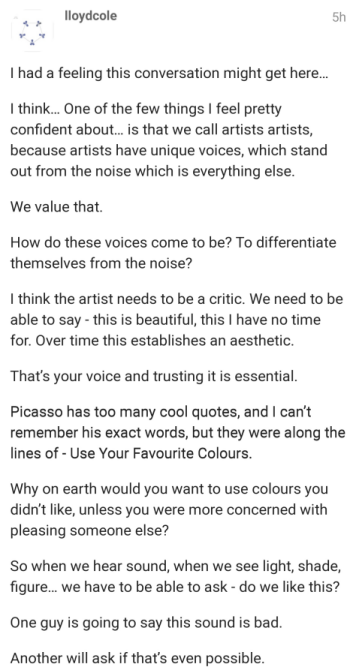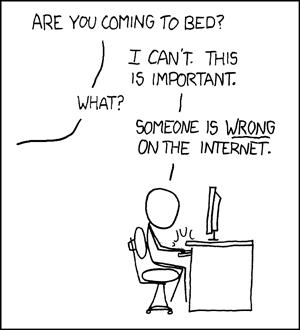Sinus congestion and its usual entourage of symptoms, plus extra back pain from sleeping poorly/in the recliner, have been keeping me down for the past few days — so I have been spending more time reading than diving into musical projects or accomplishing much else.
The Erich Fromm books I picked up were not as mind-blowing as I could have hoped. It’s partially that he was less radical than some things I’ve read in the last couple of years, partially that the subject matter only partially intersected what I was looking for, and partially that the titles and descriptions of posthumously published books might have been a little misleading.
The Art of Living is definitely more on a personal psychological level than a sociopolitical one; the idea behind it is to be “more authentically human” through self-knowledge (meditation and psychotherapy) and resistance to materialistic/consumerist modes of thought. On Disobedience is a bit of an anti-bureaucratic manifesto with equal disdain for capitalism and communism; it repeatedly decries nationalism and the nuclear arms race, praises Bertrand Russell, and provides an outline for a humanist democratic socialism.
The most important point he makes isn’t the details — he’s not an economist — but the general drive to put people first, and make the economy serve humanity instead of the other way around. Rather than abolishing property, seizing the means of production, or even an emphasis on income/wealth equality, the goal is to provide for everyone’s basic needs and education and to put businesses under partial social control of their workers and community. Work should be fulfilling and something to take pride in, rather than mind-numbing and dehumanizing. Anyone should be able to leave their job at any time to pursue further education, a career change, creative pursuits, etc.
It might be somewhat idealistic, but I prefer that to the “capitalist realism” that says that the unjust state we’re in now is the least worst possible option available.
After that, I blazed through The Apocalypse Codex and am well into The Annihilation Score. When I can’t sleep very well and need to sit up to relieve the congestion as much as possible, I get through a lot of reading. So far it seems like the Laundry Files series gets more intense with each successive book. Codex is the first to be told from the POV of someone other than Bob — in this case, Mo or “AGENT CANDID” — and I think the author scores about a 90% on making it feel like a different narrator. (In The Black Company novels, one of my favorite fantasy series, the narrative voices blur together much more and don’t feel quite as much like a real character as the people they write about.) There are two more of them on my shelf, then I’ll have to dig up The Labyrinth Index to catch up fully.
The one thing I have been doing musically is trying out the Rainmaker, which arrived yesterday afternoon (thanks to my spouse picking it up from the post office; no thanks to the lazy postal carrier who slipped a “missed delivery” notice in the mailbox instead of carrying the package to our door during one of the few times I was actually right there ready to answer it…) While I haven’t delved super deeply into it yet — and there’s a lot there to swim around in — I find it’s almost exactly what I expected from the videos I watched. Complex rather than simple and immediate, but also not difficult thanks to a well-designed interface. With a few minutes of button tapping and knob turning, I can set up neat little bouncy patterns of echoes, or warbly drunk echoes, or the sound of being at the other end of a long metal or concrete tube, or plucked strings, or all sorts of things. The pitch shifting is fairly rough granular stuff, but serviceable — and the artifacts that creates are actually useful as an effect in their own right. Overall I think this was a good choice of module for the mad sound designer in me.
The Befaco Sampling Modulator just arrived today and is sitting on my desk in a box. I’ll get to it in a bit.
As I’ve written before, the unfortunately named muffwiggler.com is something of a central hub for the synth community, especially modular synths. It went down this weekend, and one of the moderators informed people that the funds that had been donated to cover its expenses had been misappropriated for months and the owner/founder, Mike McGrath, was incommunicado.
But it had been known that Mike had been suffering from health issues, and it was already rumored that the donations were covering his medical expenses rather than the site. I… kind of can’t fault that, though I think if it were my project I’d want to be more up front that the most important creditors get paid first.
As it turns out, Mike has passed away. I didn’t know him, but those who do say he was kind, generous, and funny. I’ll take them at their word. He does deserve some credit for running a site that became such an important community and repository of information, but as I’ve also written before, the culture there was not without its problems. Specifically, toxic masculinity problems. Starting with the name of the forum (which was Mike’s own online handle, and came from a pair of Electro-Harmonix FX pedals from the 70s), which establishes a sort of locker room atmosphere, there are also several users with lewd (just short of pornographic) profile pictures, mildly transphobic or sexist jokes, and just a general sense of… stuff that doesn’t need to be on a synth forum and doesn’t make women, nonbinary, queer, or just generally tasteful people feel comfortable. And those things are all unnecessary and could be fixed with a name change and a small policy change. But of course, to a certain type of white guy, it’s just a bit of fun and no harm done and us SJWs need to not be so sensitive… 😛
Discussions of that have run headfirst into (A) the kind of people who deny that toxic masculinity exists or is a real problem, and (B) people calling for respect for the dead.
SynthCube, who sells DIY kits, covered the past due bills and got the site running again. The moderator team is deciding what to do next, but promises that the content will be preserved and they are committed to “preserving Mike’s legacy.” By that I hope they don’t mean preserving the unnecessary sexism. But any discussion of that is killed immediately by the moderators, so I don’t have a lot of hope for that.
The latest word is that Mike wanted his daughter Kira to take over running the forum, which she will do after some time to grieve. She and the rest of his family seem to be fine with the “Muff Wiggler” name at the moment, but I have some hope that she’ll take an active role in the forum and community and make at least some of the changes so many of us want.


